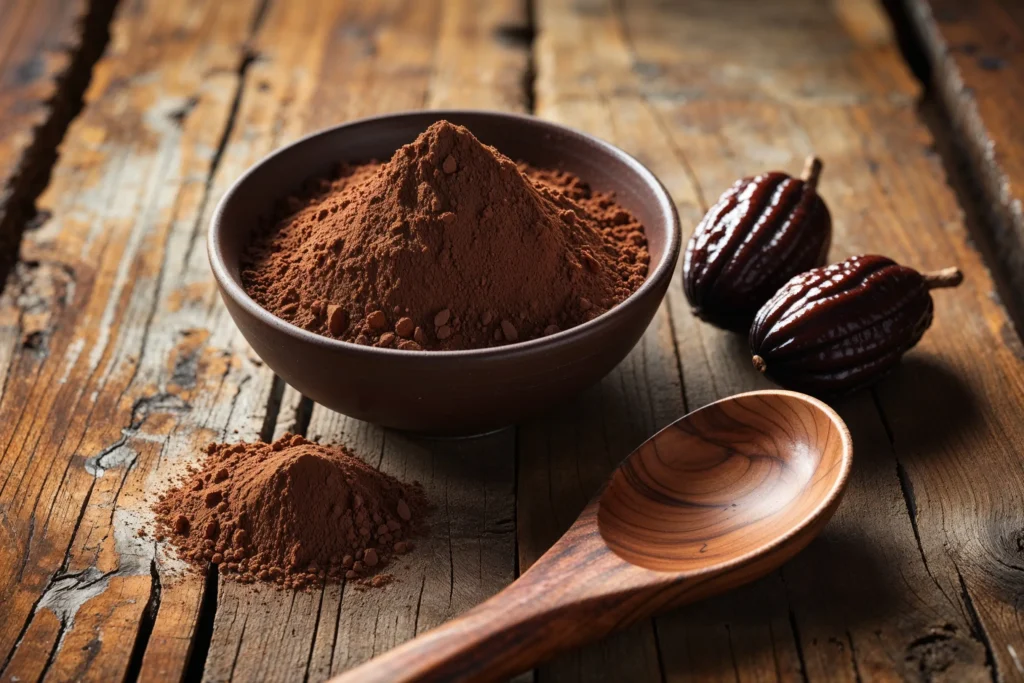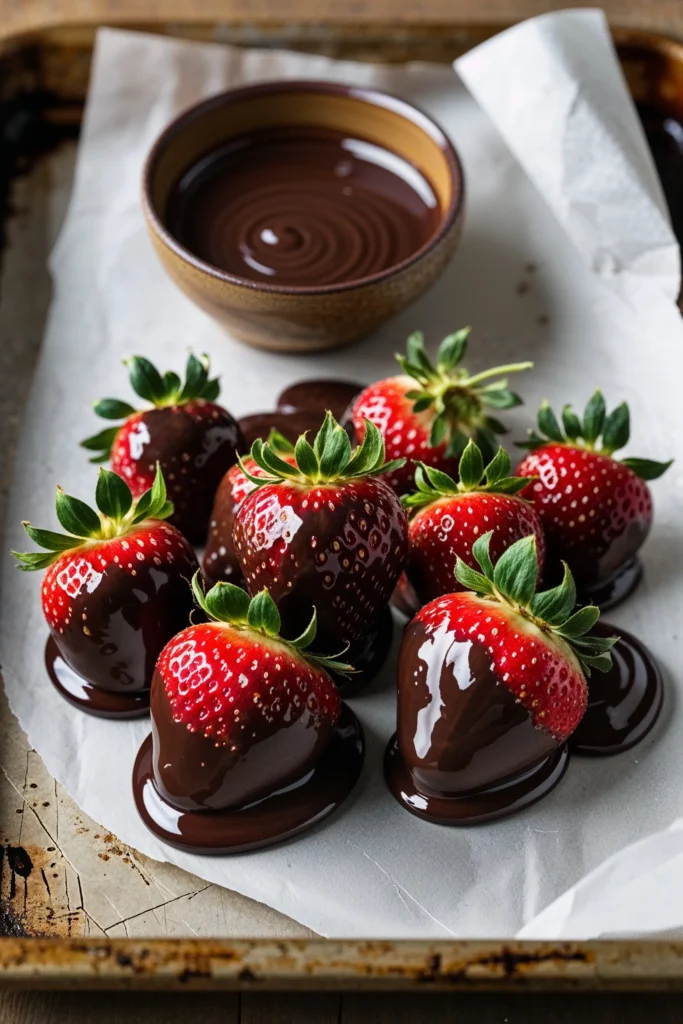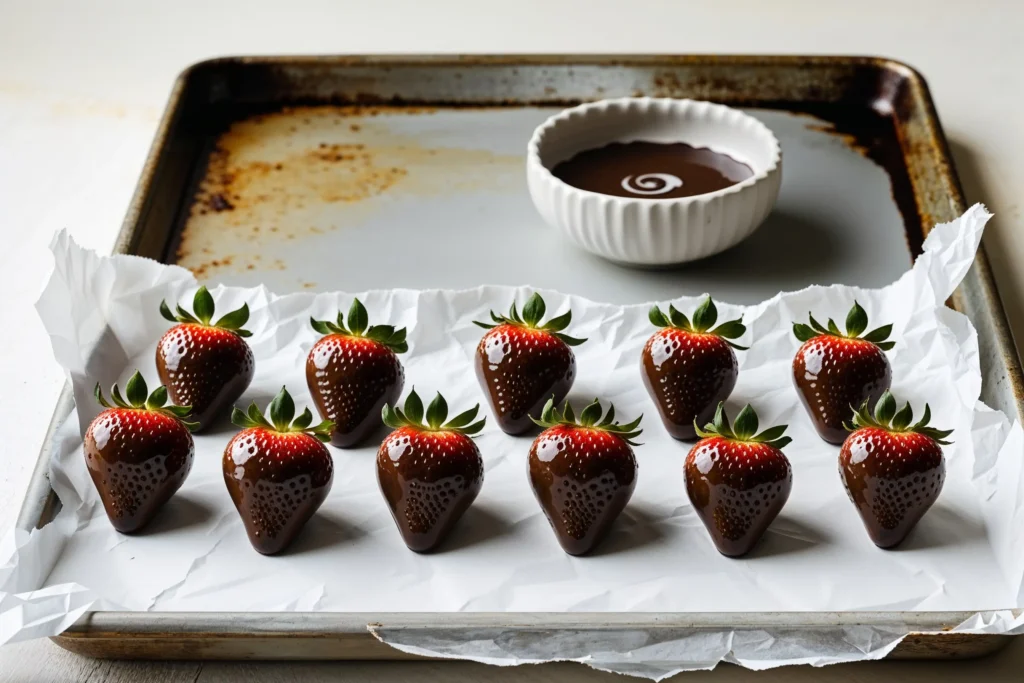Table of contents
Estimated reading time: 11 minutes
What is Carob, and Why Choose It for a Carob Covered Strawberries Recipe?
Carob is a naturally sweet and nutrient-rich alternative to cocoa derived from the pods of the Ceratonia siliqua tree, commonly found in Mediterranean regions. Unlike cocoa, carob is free from caffeine and theobromine, making it a preferred choice for those sensitive to stimulants or seeking a gentler alternative. Its subtly sweet flavor and rich texture make it ideal for creating delectable treats like a carob covered strawberries recipe.
One key advantage of carob is its nutritional profile. It is packed with essential minerals like calcium, potassium, and magnesium, which support overall well-being. Additionally, carob contains dietary fiber that promotes healthy digestion and helps maintain a balanced diet. This makes it an appealing option for health-conscious individuals and those following specialized diets, including vegan and gluten-free.
Another reason to consider carob is its naturally sweet taste, which eliminates the need for added sugars in recipes. This characteristic makes it perfect for crafting desserts like carob covered strawberries recipes that cater to both indulgence and wellness. As more people embrace healthier lifestyles, carob’s versatility and unique benefits continue to gain popularity as a wholesome alternative to traditional chocolate.

Essential Ingredients for the Perfect Carob Covered Strawberries Recipe
Creating a delightful carob covered strawberries recipe begins with simple, wholesome ingredients that prioritize both taste and health. Each component contributes to the perfect balance of flavors and textures, ensuring your strawberries are both indulgent and nourishing.
- Fresh Strawberries: Choose ripe, firm strawberries with bright red color and vibrant green leaves. These provide the foundation of the recipe and their natural sweetness pairs wonderfully with carob.
- Carob Powder: Opt for high-quality carob powder, free from additives. This key ingredient lends its distinct sweetness and rich flavor to the coating.
- Coconut Oil: Used to achieve the perfect consistency for dipping, coconut oil also adds a subtle richness to the carob coating.
- Maple Syrup or Honey (optional): For those who prefer an extra touch of sweetness, a small amount of natural sweetener can enhance the flavor without overpowering it.
- Vanilla Extract (optional): A hint of vanilla can deepen the flavor profile, creating a more aromatic experience.

These straightforward ingredients make preparing carob covered strawberries recipes easy and enjoyable, combining simplicity with natural goodness. Whether for a special occasion or a healthy treat, this recipe is sure to delight.
Tools You Need to Make Your Carob Covered Strawberries Recipe Easy
Preparing a carob covered strawberries recipe is straightforward when you have the right tools at hand. Each item plays a key role in ensuring a smooth and enjoyable cooking process.
- Mixing Bowl: A medium-sized bowl is essential for combining the carob coating ingredients. Choose one with enough depth to allow easy mixing and dipping.
- Double Boiler or Heatproof Bowl: Melting the carob mixture gently over a double boiler prevents scorching and creates a smooth, even texture.
- Parchment Paper: Line your tray with parchment paper to prevent the dipped strawberries from sticking during the cooling process.
- Baking Tray: Use a flat tray to arrange the coated strawberries for setting. A sturdy tray helps maintain their shape and ensures even cooling.
- Fork or Dipping Tool: For easy handling, a fork or specialized dipping tool allows you to coat the strawberries evenly without making a mess.
- Spoon or Spatula: A spoon or small spatula helps mix the carob coating thoroughly, ensuring a uniform consistency.
These tools make assembling a carob covered strawberries recipe efficient and enjoyable, ensuring every step of the process is seamless and satisfying.
Step-by-Step Instructions for Crafting a Carob Covered Strawberries Recipe

Creating a perfect carob covered strawberries recipe is simple and enjoyable when broken into easy steps. Follow these instructions to achieve a delightful treat that is both healthy and indulgent.
- Prepare the Strawberries: Wash the strawberries thoroughly and pat them dry with a clean kitchen towel. Any moisture can affect the coating’s texture, so ensure they are completely dry.
- Melt the Carob Coating: In a heatproof bowl over a pot of simmering water (double boiler method), combine the carob powder and coconut oil. Stir gently until the mixture is smooth and free of lumps.
- Add Sweetener and Flavoring (Optional): If desired, mix in a small amount of maple syrup or honey for sweetness and a few drops of vanilla extract to enrich the flavor.
- Dip the Strawberries: Hold each strawberry by the stem and dip it into the melted carob mixture, turning to coat evenly. Allow any excess coating to drip off before placing the strawberry on parchment-lined baking tray.
- Set the Coated Strawberries: Place the tray in the refrigerator for 20–30 minutes, or until the coating is firm and glossy.
- Serve and Enjoy: Arrange the strawberries on a serving plate and enjoy your freshly made carob covered strawberries recipe!

Creative Variations to Customize Your Carob Covered Strawberries Recipe
Adding a twist to your carob covered strawberries recipe allows you to tailor the treat to different preferences or occasions. These creative variations ensure variety while keeping the process enjoyable.
- Nutty Crunch: Before the carob coating sets, roll the dipped strawberries in finely chopped nuts such as almonds, pistachios, or hazelnuts. This adds a delightful crunch and complements the natural sweetness of the carob.
- Coconut Bliss: Sprinkle shredded coconut over the wet coating for a tropical flair. The coconut’s light texture pairs beautifully with the creamy carob.
- Dark and Light Layers: Dip the strawberries partially in melted white carob or yogurt-based coating after the initial layer sets, creating a two-toned effect.
- Berry Burst: Mix a small amount of freeze-dried strawberry powder into the carob coating for an extra fruity twist.
- Spiced Delight: Add a pinch of cinnamon or chili powder to the carob mixture for a subtle kick that enhances the flavor complexity.
- Drizzled Art: Once the coating hardens, drizzle a contrasting color, like white carob, in thin lines for an elegant finish.
These variations let you customize your carob covered strawberries recipe, adding flair and flavor to this classic treat.
How to Store Your Carob Covered Strawberries Recipe for Freshness
Proper storage is key to preserving the freshness and texture of your carob covered strawberries recipe. With a few simple steps, you can enjoy them at their best even a day or two after preparation.
- Cooling Before Storage: Allow the carob coating to fully harden before placing the strawberries into a container. This step prevents sticking and maintains their glossy finish.
- Choose the Right Container: Select an airtight container that minimizes exposure to air and moisture. Line the bottom with parchment paper to avoid sticking and maintain the coating’s integrity.
- Single Layer Placement: Arrange the strawberries in a single layer inside the container. Stacking them can damage the coating or cause the strawberries to become mushy.
- Refrigeration: Store the container in the refrigerator to keep the strawberries fresh. They should remain cool to prevent the carob coating from melting or softening.
- Consume Within Two Days: For the best taste and texture, enjoy your strawberries within 24–48 hours. While refrigeration helps extend their shelf life, the strawberries are freshest when eaten soon after preparation.
These storage tips will keep your carob covered strawberries recipe delicious and ready to enjoy whenever you crave a sweet, healthy treat.
Serving Suggestions
Presenting your carob covered strawberries recipe in creative and thoughtful ways can enhance the experience for your guests and add a special touch to any occasion. Here are some serving ideas to make this treat even more delightful.
- Platter Perfection: Arrange the strawberries on a decorative platter, spacing them evenly for a clean and inviting presentation. Adding a few sprigs of mint as a garnish can provide a pop of color and a hint of freshness.
- Individual Servings: Place a few strawberries in small ramekins or decorative cupcake liners. This not only adds charm but also makes serving easier for gatherings.
- Dessert Board: Include the strawberries as part of a dessert board alongside other treats like nuts, dried fruits, and small cookies. The variety will appeal to different tastes.
- Paired with Beverages: Serve the strawberries with a complementary drink such as sparkling water, herbal tea, or a light dessert wine. The pairing elevates the overall indulgence.
- Themed Presentation: Customize the look for holidays or events by incorporating themed decorations like colorful ribbons or matching tableware.
These serving suggestions highlight the versatility of your carob covered strawberries recipe, making it perfect for everything from casual snacks to sophisticated desserts.
Common Mistakes to Avoid
Making carob covered strawberries recipes can be a straightforward and rewarding process, but a few common missteps can affect the outcome. By keeping these tips in mind, you can avoid potential pitfalls and create a flawless treat.
- Skipping the Drying Step: Failing to dry the strawberries completely after washing can cause the carob coating to slide off or prevent it from adhering properly.
- Overheating the Carob Mixture: Heating carob at too high a temperature can lead to a grainy texture or burnt flavor. Always melt it gently using a double boiler or a similar method.
- Neglecting Consistency: If the carob mixture is too thick or too thin, it may not coat the strawberries evenly. Adjust with small amounts of coconut oil to reach the ideal texture.
- Rushing the Setting Process: Placing the strawberries in a warm or humid area can delay the setting or cause the coating to melt. Refrigerate them immediately to solidify the coating.
- Improper Storage: Storing coated strawberries in an uncovered or improperly sealed container can lead to dryness or sogginess.
By avoiding these mistakes, you’ll consistently achieve beautifully coated strawberries that look and taste incredible.
Health Benefits of Carob Covered Strawberries
A carob covered strawberries recipe offers not just a delicious treat but also a range of health benefits that make it a guilt-free indulgence. Combining the natural sweetness of strawberries with nutrient-rich carob creates a dessert that supports wellness while satisfying your sweet tooth.
- Rich in Antioxidants: Strawberries are packed with vitamin C and powerful antioxidants that help protect the body from free radicals, supporting overall cellular health. Carob also contains polyphenols, which contribute to its antioxidant properties.
- Low in Fat and Calories: Carob is naturally low in fat and calories compared to traditional chocolate, making it an excellent choice for those seeking lighter dessert options without compromising flavor.
- Caffeine-Free Alternative: Unlike cocoa, carob is caffeine-free, making it a suitable treat for people sensitive to stimulants or looking for a dessert that can be enjoyed at any time of day.
- Supports Digestive Health: Both strawberries and carob contain dietary fiber, which promotes healthy digestion and may help maintain balanced blood sugar levels.
- Nutrient Boost: Carob is a good source of calcium, while strawberries provide folate and potassium, creating a nutrient-dense combination.
Enjoying this recipe can be a delightful way to incorporate both flavor and health benefits into your diet.

Conclusion and Final Tips
Crafting a carob covered strawberries recipe is an enjoyable way to blend natural ingredients into a treat that delights the palate and supports healthier choices. This dessert is simple to prepare, versatile for any occasion, and a thoughtful alternative to traditional chocolate-dipped strawberries.
To achieve the best results, always select the freshest strawberries and high-quality carob powder for a rich and satisfying flavor. Taking care during each step—such as ensuring the strawberries are completely dry and melting the carob gently—makes a noticeable difference in the final outcome.
For added variety, consider experimenting with creative toppings like nuts, coconut, or spices. If serving for a special event, personalize the presentation to match the occasion, whether it’s a holiday, birthday, or a casual gathering.
When storing the strawberries, refrigeration is key to maintaining their freshness and texture. However, they are best enjoyed within a day or two for optimal flavor.
With this recipe, you can create a delicious and visually appealing treat that balances indulgence with mindful eating. Whether for yourself or to share with loved ones, carob covered strawberries offer a sweet moment to savor and enjoy.
